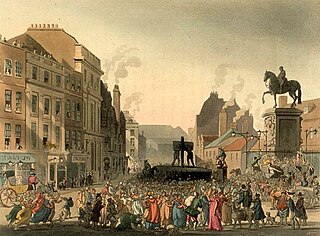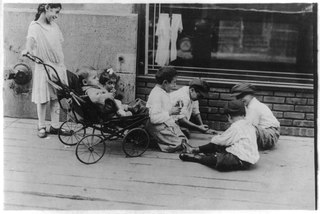Origin and meaning
Although the earliest known record of the song is from the mid-eighteenth century, [4] there is some evidence that it is much older. The death of a robin by an arrow is depicted in a 15th-century stained glass window at Buckland Rectory, Gloucestershire. [5] The rhyme is similar to a poem, Phyllyp Sparowe, written by John Skelton about 1508, in which the narrator laments the death of his pet bird. [1] The use of the rhyme 'owl' with 'shovel' could suggest that it was originally used in older middle English pronunciation. [1] Versions of the story appear to exist in other countries, including Germany. [1]
A number of theories have been advanced to explain the meaning of the rhyme:
- The rhyme records a mythological event, such as the death of the god Balder from Norse mythology, [1] or the ritual sacrifice of a king figure, as proposed by early folklorists as in the 'Cutty Wren' theory of a 'pagan survival'. [6] [7]
- It is a parody of the death of King William II, who was killed by an arrow while hunting in the New Forest (Hampshire) in 1100, and who was known as William Rufus, meaning "red". [8]
- The rhyme is connected with the fall of Robert Walpole's government in 1742, since Robin is a diminutive form of Robert and the first printing is close to the time of the events mentioned. [1]
- According to Celtic traditions, Lugh, the sun god who dies as the nights get longer after the summer solstice, is marked in the old Celtic pictographic calendar with a bow-and-arrow shape. Lugh was the primary god representing the red sun and was also known in Welsh as "Coch Rhi Ben", anglicised to "Cock Robin" (coch meaning red, rhi meaning lord and ben meaning leader – a nod to the belief that souls became birds after death). The sparrow who kills him with "my bow and arrow" represents Brân the Blessed – the god of winter in the form of a raven.
All of these theories are based on perceived similarities in the text to legendary or historical events, or on the similarities of names. Peter Opie pointed out that an existing rhyme could have been adapted to fit the circumstances of political events in the eighteenth century. [1]
The theme of Cock Robin's death as well as the poem's distinctive cadence have become archetypes, much used in literary fiction and other works of art, from poems, to murder mysteries, to cartoons. [1]

A nursery rhyme is a traditional poem or song for children in Britain and many other countries, but usage of the term dates only from the late 18th/early 19th century. The term Mother Goose rhymes is interchangeable with nursery rhymes.

"Ring a Ring o' Roses", "Ring a Ring o' Rosie", or "Ring Around the Rosie", is a nursery rhyme, folk song and playground singing game. Descriptions first emerge in the mid-19th century, but are reported as dating from decades before, and similar rhymes are known from across Europe, with various lyrics. It has a Roud Folk Song Index number of 7925.
A children's song may be a nursery rhyme set to music, a song that children invent and share among themselves or a modern creation intended for entertainment, use in the home or education. Although children's songs have been recorded and studied in some cultures more than others, they appear to be universal in human society.

"As I was going by Charing Cross", is an English language nursery rhyme. The rhyme was first recorded in the 1840s, but it may have older origins in street cries and verse of the seventeenth century. It refers to the equestrian statue of King Charles I in Charing Cross, London, and may allude to his death or be a puritan satire on royalist reactions to his execution. It was not recorded in its modern form until the mid-nineteenth century. It has a Roud Folk Song Index number of 20564.

"Ding Dong Bell" or "Ding Dong Dell" is a popular English language nursery rhyme. It has a Roud Folk Song Index number of 12853.
"Goosey Goosey Gander" is an English-language nursery rhyme. It has a Roud Folk Song Index number of 6488.

"This Is the House That Jack Built" is a popular English nursery rhyme and cumulative tale. It has a Roud Folk Song Index number of 20854. It is Aarne–Thompson–Uther Index type 2035.

"The Blossom" is a poem by William Blake, published in Songs of Innocence in 1789.
Robyn and Gandeleyn is an English ballad. The poem is in Sloane Manuscript 2593, a document of lyrics and carols which dates from around 1450. It was first printed by Joseph Ritson in his 1790 collection Ancient Songs. It was later republished in the second half of the 19th century in an anthology of traditional English and Scottish ballads by Francis James Child known as the Child Ballads, where it is Child Ballad 115. Child also divided the continuous text into seventeen stanzas.

Childlore is the folklore or folk culture of children and young people. It includes, for example, rhymes and games played in the school playground. The best known researchers of the field were Iona and Peter Opie.
"Taffy was a Welshman" is an English language nursery rhyme which was popular between the eighteenth and twentieth centuries. It has a Roud Folk Song Index number of 19237.
"I Love Little Pussy", alternatively called "I Love Little Kitty", is an English language nursery rhyme about a person who is kind to a pet cat. It has a Roud Folk Song Index number of 12824.

"The Dowie Dens o Yarrow", also known as "The Braes of Yarrow" or simply "Yarrow", is a Scottish border ballad. It has many variants and it has been printed as a broadside, as well as published in song collections. It is considered to be a folk standard, and many different singers have performed and recorded it.
"The Cutty Wren" and its variants such as "The Hunting of the Wren" are traditional English folk songs. The origins and meaning of the song are disputed. It is number 236 in the Roud Folk Song Index.

"Ride a Cock Horse to Banbury Cross" is an English language nursery rhyme connected with the English town Banbury in Oxfordshire. It has a Roud Folk Song Index number of 21143.

'I Had a Little Nut Tree' is an English language nursery rhyme. It has a Roud Folk Song Index number of 3749.The song mentions a visit by the daughter of the King of Spain to request nutmeg and a pear. James Orchard Halliwell suggested that the song commemorates the 1506 visit of the Queen regnant Joanna of Castile to the English court of her brother-in-law, Henry VIII. However, the oldest known version of the song dates to 1797.

‘Little Robin Redbreast’ is an English language nursery rhyme, chiefly notable as evidence of the way traditional rhymes are changed and edited. It has a Roud Folk Song Index number of 20612.

Harlequin Cock Robin and Jenny Wren; or, Fortunatus and the Water of Life, the Three Bears, the Three Gifts, the Three Wishes, and the Little Man who Woo'd the Little Maid was a pantomime written by W. S. Gilbert. As with many pantomimes of the Victorian era, the piece consisted of a story involving evil spirits, young lovers and "transformation" scenes, followed by a harlequinade.
Who Killed Cock Robin is a Silly Symphonies short released on June 26, 1935, by United Artists, produced by Walt Disney and directed by David Hand. It is based on the nursery rhyme Who Killed Cock Robin?. It was nominated for the Best Short Subject (Cartoons) Oscar but lost to Disney's own Three Orphan Kittens.

The recorded source of the children's story The Marriage of Robin Redbreast and the Wren is Isabella Burns, later Mrs Isabella Burns Begg, the youngest sister of Robert Burns. Isabella recalled that her brother, Robert Burns, was the author and that he was in the habit of telling the tale to entertain the younger members of his family at Lochlea Farm, such as herself, Annabella, John and William. This nursery tale was first published by Dr Robert Chambers in his "Popular Rhymes of Scotland".













